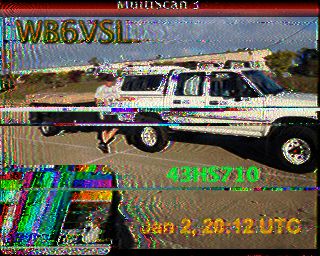
 {And now.
{And now.
SSTV (Slow Scan Television)
SSTV is a mode that uses a computer and an amateur radio transceiver to send and receive still images over radio. SSTV was originally an analogue mode based on Frequency Modulation (FM). Digital SSTV has become possible with little trouble in recent times with the use of Digital Radio Mondiale (DRM). Despite the name television SSTV cannot send or receive moving pictures; it is more akin to sending a FAX. For SSTV to work, an image is broken into lines, composed of dots of color and light intensity known as pixels. Each pixel is given a specific audio frequency ( that modulates the carrier) depending on its brightness. In a color image, each of the primary colors, red green and blue are analyzed for brightness. The lines of a picture are scanned from left to right. The modulating frequency varies between 1500Hz and 2300 Hz. There are a number of modes used for SSTV - see below for information. Computer software attaches a Vertical Interval Signaling (VIS) code at the start of a picture being sent. this enables receiving software to determine which mode is being used, and hence permits successful decoding of the signal. The color and brightness information modulates a carrier wave for transmission. A remote station picks up the signal and a computer is used to recreate the picture from the FM signal. SSTV should not be confused with amateur Fast-Scan Television, often simply called Amateur Television or ATV. Now with SSTV you have a choice of software to choose from. I use MMSTV but you can use Mixw or multiPSK. When I started doing SSTV back in 1980 using a Robot model 1200c scan converter with a P7 CRT screen.It had a yellow tint to it. A yellow filter was placed in front to cut down the white light from the p7 CRT screen which made it easier to look at.Problem was, it was bulky and scanned views weren't persistent on CRT Screen.In order to keep pictures so you could look at them later I used a cassette recorder to play recorded audio off the air.The pictures at the bottom illustrate what it was like compared to present.Color now is the norm and is sent using different modes like (Scotty) or (Scotty2) as an example.
In Aug. 1981 all the ham operators were anxious to receive pictures that would be sent from JPL (Jet Propulsion Laboratory). The first pictures were sent back to earth from voyager2 and sent out on 20 meters 14.230mhz.What a site to see the clarity even though it was on a P7 CRT tube.